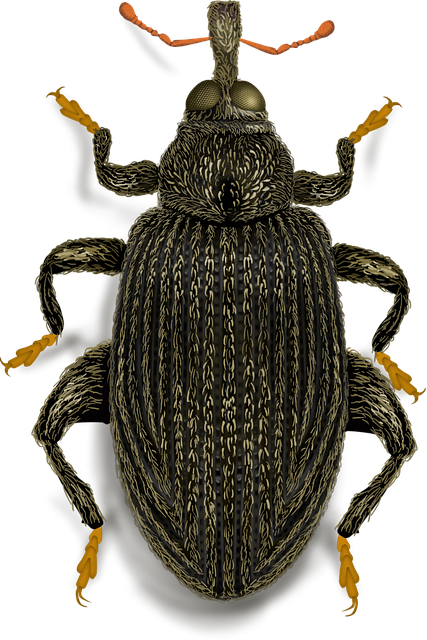Stinging insects like bees and hornets, vital pollinators but potential pests when nesting near humans, can be safely managed by professional stinging pest control services. These experts employ tailored, humane methods and specialized equipment for effective extermination while minimizing environmental impact. Services cater to both residential and commercial needs, focusing on secure removal rather than complete eradication. Preventing re-infestation is key; professionals offer eco-friendly solutions including pesticide application, entry point sealing, and preventive advice. Regular inspections ensure early nest detection and ongoing pest control for safe, stinging-insect-free environments.
In many regions, bees and stinging insects play a vital role in local ecosystems. However, when they invade residential or commercial spaces, they pose significant risks. This article guides you through humane and ethical approaches to managing these stinging pests. From understanding their behavior and habitats to implementing safe removal techniques and preventing re-infestation, we cover everything you need to know about effective yet responsible stinging pest control services, including professional wasp removal, bee and hornet control, and extermination options for both residential and commercial settings.
Understanding Stinging Insects: Behavior and Habitat
Stinging insects, such as bees and hornets, play a vital role in our ecosystem, primarily acting as pollinators. However, when they establish nests near human habitats, especially in residential or commercial areas, their presence can become problematic and even dangerous. Understanding these insects’ behavior and habitat is crucial for effective and humane removal.
These pests are social creatures that live in colonies with a queen, workers, and drones. They build nests made of paper-like material chewed from wood or other sources. Bees and hornets are most active during the day, constructing and maintaining their nests and foraging for food. Identifying their entry points and nest locations is key to successful professional wasp removal or bee and hornet control. Stinging pest control services often employ specialized techniques and equipment to ensure safe and effective extermination while minimizing disruption to surrounding environments and other non-target species.
Safe and Humane Removal Techniques for Bees and Wasps
When dealing with bees and wasps, safe and humane removal techniques are paramount to protect both humans and the insects themselves. Professional wasp removal services often employ specialized equipment and trained technicians to ensure minimal distress to the pests while effectively mitigating potential risks. These experts utilize various methods tailored to specific species, such as bee and hornet control, to prevent stinging insect extermination from becoming a hazardous scenario.
For residential areas, pest control for stinging insects should focus on safe removal rather than complete eradication. Professional stinging pest control services offer solutions for both homeowners and commercial properties, providing peace of mind by addressing the issue humanely. By employing these skilled practitioners, you can rest assured that any bee or wasp presence will be handled with care, efficiency, and respect for their role in the ecosystem.
Professional Wasp and Bee Control Services: When to Call Experts
Many homeowners and business owners face the dilemma of dealing with bee and hornet infestations, often requiring professional wasp removal. While some may opt for DIY solutions, stinging pest control services are best left to experts when it comes to humane and ethical insect extermination. These professionals are equipped with specialized knowledge and equipment to handle these situations safely and effectively.
When considering residential or commercial stinging pest services, look for companies that prioritize non-lethal methods and environmentally friendly practices. Bee and hornet control should involve the relocation of bees rather than immediate extermination. This approach ensures the safety of both humans and beneficial insects while maintaining a balanced ecosystem. Professional wasp removal experts can assess the situation, provide guidance on prevention, and implement tailored solutions for any scale of infestation.
Preventing Re-infestation: Post-Removal Strategies for Stinging Insect Control
After successfully removing bees or hornets from a property, preventing re-infestation is paramount to maintain a safe and pest-free environment. Stinging pests are attracted to sweet substances and specific types of plants, so eliminating potential food sources nearby can significantly reduce their return. Professional stinging insect control services often offer comprehensive solutions that include treating the initial nest site with eco-friendly or organic pesticides to disrupt any remaining eggs or larvae.
For effective long-term stinging pest management, residential and commercial customers should partner with experts who specialize in bee and hornet control. These professionals can provide tailored advice on sealing entry points, removing potential nesting sites, and treating plants that might attract these insects. Regular inspections and maintenance are key to ensuring any new nests are identified early, preventing widespread re-infestation, and keeping residents or employees safe from potentially harmful stinging insect encounters.
When dealing with stinging pests like bees and wasps, a balanced approach that combines understanding their behaviors with effective removal techniques is key. While some situations may require professional wasp and bee control services, many cases can be safely handled using humane removal techniques. Implementing post-removal strategies, such as sealing entry points and eliminating food sources, helps prevent re-infestation. For both residential stinging pest services and commercial settings, proactive measures and knowledge of local regulations regarding stinging insect extermination are essential for maintaining safe, bee- and hornet-free environments.
